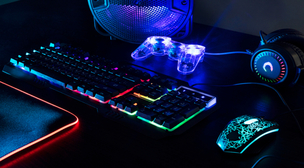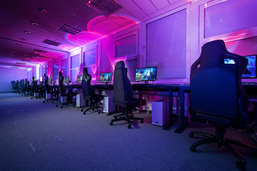Updated: June 6, 2022
Virtual reality is rapidly gaining traction in the game market, and with Facebook's move to META, it may happen faster than anyone anticipated. High-definition images, easy viewing, and a diverse selection of games are all requirements for VR systems. We've put the finest VR headsets from Valve, Oculus, HTC, HP, Samsung, and more to the test to bring you the authoritative list of the best VR headsets available today.
There are a plethora of VR headsets to select from, perhaps an excessive number. However, choosing between a fully connected headset and a standalone headset is an easy way to limit things down. Traditionally, PC gamers have insisted that the VR headset be powered by our gaming PC, but with some standalone headsets, this is no longer the case.
And once you're running your shiny new headset, we recommend you jump into Half-Life: Alyx. That stunning Half-Life sequel is almost worth the entry price alone. But once you've scoured the streets of City 17 for Combine to kill and Headcrab zombies to avoid, you can sit back and watch a movie writ large on a virtual cinema screen, fly an X-Wing in Star Wars: Squadrons, or even paint a physics-bending mural in a virtual space.
It really is a great time to get into virtual reality.
Best VR headsets

1. Oculus Quest 2
The best VR headset
SPECIFICATIONS
Display: LCD
Resolution: 3664 x 1920
Refresh Rate: Up to 120 Hz
Field of View: 100 degrees
Controllers: Oculus Touch
Connections: USB Type-C, 3.5mm headphone
TODAY'S BEST DEALS
RECOMMENDED RETAILER
Prime
REASONS TO BUY
+Oculus Link tethering+Improved graphics+Great price
REASONS TO AVOID
-Mandatory Facebook login-Fiddly strap
The Oculus Quest 2 both improves on the specs sheet of the original Quest and delivers it for cheaper. With a new LCD at 1832 x 1920 per eye, the Quest 2 offers exceptional clarity for an entry-level headset, through which you can enjoy a slew of games either purpose-built for the standalone headset, and thus rendered by the onboard Snapdragon XR2 chip, or beamed from your PC using Oculus Link and a compatible USB Type-C cable.
Thanks to Oculus Link, the Quest 2 becomes more than a standalone VR headset. It becomes an all-in-one VR Swiss army knife, capable of great on-the-move VR and gaming across SteamVR and Oculus Rift compatible titles. It's now capable of up to 120Hz refresh rate, thanks to a recent update, making it an even sweeter deal.
The Quest 2 is also one of the quickest headsets to get up and running on this list. With Inside-Out tracking and hand tracking built-in, you can go from unboxing to up-and-running in VR in just a couple of minutes. The Quest 2 has also enjoyed a boost in memory capacity recently, and $299 new gets you a 128GB model, which is a sweet boost indeed.
There's only one hitch in the Oculus Quest 2's plan for virtual world domination: compulsory Facebook account login. The Oculus Quest 2 requires a Facebook account. The company says it's to better serve you, the customer, with services and products, although for a good while there the only discernible 'benefit' was direct to feed screenshots. Not great. If you're not a fan of Facebook's practices then you'd best scroll further down the list for a VR headset worth investing in.
Read our full Oculus Quest 2 review.

2. Valve Index
The best VR headset for a premium experience on a gaming PC
SPECIFICATIONS
Display: AMOLED
Resolution: 2880 x 1600
Refresh Rate: 120 Hz, experimental 144 Hz mode
Field of View: ~130 degrees
Controllers: Index Controllers
Connections: DisplayPort, USB 3.0, USB 2.0
TODAY'S BEST DEALS
Prime
Prime
REASONS TO BUY
+Best in class hardware+Comfortable to wear+Virtually no SDE
REASONS TO AVOID
-Setup is awkward-Limited support for finger-tracking
Advertisement
The Valve Index boasts some of the best visuals of any mainstream, commercially available HMD, with a display resolution equaling the Vive Pro, Quest, and Odyssey+ but paired with a 120Hz refresh rate (up to 144Hz in a currently unsupported, experimental mode). The FOV, at 130°, is also best-in-class, and there's virtually no detectable screen door effect inside the headset.
It also boasts some impressive technology and handy convenience features, like per-finger tracking on the excellent Index controllers, USB passthrough for future accessories, and fantastic, crystal clear audio via the near-field speakers, which hover just off the ears. It's also comfortable to wear, built from carefully selected, high-quality materials, with top-notch weight distribution.
But all that comes at a price. It's the best VR headset on the market... if you don't consider the value proposition. At nearly a thousand dollars, the complete Index package costs as much as three Quest 2s. There aren't many solid use cases for the finger tracking technology either, apart from Half-Life: Alyx, which you get for free.
Read our full Valve Index review.
Best gaming keyboard | Best gaming chairs | Best mechanical keyboard| Best wireless gaming mouse | Best wireless gaming keyboard

3. HTC Vive Pro 2
The best display in a mainstream VR headset so far, but it'll cost you.
SPECIFICATIONS
Display: LCD
Resolution: 4896 x 2448
Refresh Rate: 120 Hz
Field of View: 120 degrees
Controllers: HTC Vive
Connections: DisplayPort 1.2, USB 3.0
TODAY'S BEST DEALS
Prime
REASONS TO BUY
+Awesome display+Precise tracking+Mature tracking
REASONS TO AVOID
-Ridiculously expensive-Takes time to setup-Gets hot in use
Advertisement
The HTC Vive Pro 2 is the latest headset to hit the market, and it brings with it a number of updates on the display front to make it one of the most impressive mainstream options around. The native resolution of 2,448 x 2,448 pixels per eye is incredible, and when coupled with the 120Hz refresh rate and 120-degree field of view, makes for one of the best viewing experiences around.
HTC has stuck with the satellite setup for the Vive Pro 2 to ensure you get accurate controller tracking, which means you'll need plenty of power sockets to get everything up and running. The full starter kit comprises the headset, two first-generation controllers, and a pair of Base Station 2.0 satellites. The headset is available on its own as well, which is useful if you're upgrading from a first-generation setup. That full-kit is surprisingly pricey at $1,399 (£1,299), while the headset on its own will set you back $799 (£719). Not exactly cheap.
It's a pricey upgrade over the Valve Index and doesn't do enough beyond the improved display to really justify that cost. Still, if you're looking for the very best display around, particularly as an upgrade, there's certainly a case to be made for the Vive Pro 2. It's a shame the starter kit is so expensive really.
Read our full HTC Vive Pro 2 review.
4. HP Reverb G2
The best VR headset from the Windows Mixed Reality group
SPECIFICATIONS
Display: LCD
Resolution: 4320 x 2160
Refresh Rate: 90 Hz
Field of View: ~114 degrees
Controller: Odyssey Controllers
Connections: DisplayPort 1.3, USB 3.0
TODAY'S BEST DEALS
RECOMMENDED RETAILER
Prime
REASONS TO BUY
+Easy setup and long cable+Accessible physical IPD Toggle+No screen door effect
REASONS TO AVOID
-FOV below average-Limited tracking volume
Advertisement
The HP Reverb G2 has won a place here with the best VR headsets, thanks in no small part to its fantastic resolution. If future-proofing your setup in terms of image fidelity is your main concern, it will not disappoint. With 2160p per eye, the Reverb G2 manages to completely alleviate the screen door effect that can cause issues with some lower resolution headsets—provided you have a powerful enough GPU to handle it.
Still, even playing in lower resolutions, you get to take advantage of great features like the highly inclusive, physical IPD toggle on the underside of the headset; the range is impressive compared to other options on the market. You also get a lovely long cable for large spaces and a comfortable headset, though it does fall a little in terms of FOV.
The tracking space is also a little limited without base stations. Still, HP counters this with fantastic IMU gyro sensors that are pretty good at predicting movements beyond the tracking area, as long as they are fluid. Holding your hands still tells a different story, but this shouldn't make a difference in most in-game situations.
So while the Reverb G2 might not have all the fancy greebles of some of the other headsets on the list, it has enough great features that do make it worth a look for the money.
Read our full HP Reverb G2 review.

5. HTC Vive Cosmos Elite
HTC goes back to base stations for improved accuracy
SPECIFICATIONS
Display: LCD
Resolution: 2880 x 1700
Refresh Rate: 90 Hz
Field of View: 110 degrees
Controllers: 1st-gen Vive Controllers
Connections: DisplayPort 1.2, USB 3.0
TODAY'S BEST DEALS
REASONS TO BUY
+High resolutions displays+Accurate tracking+Includes Half-Life: Alyx and Viveport Infinity
REASONS TO AVOID
-First-gen controllers and base stations-Not massively innovative
Advertisement
The HTC Vive Cosmos Elite is designed to address some of the original HTC Vive Cosmos problems while maintaining that model's core specifications. The dual 4.3-inch 1440 x 1700 displays running at 90 Hz really are worth holding on to. The Cosmos Elite comes bundled with Half-Life: Alyx and 6-months of Viveport Infinity subscription, which at the very least means there are lots of things to try out with your new headset.
The Cosmos Elite is essentially the original Cosmos bundled with the first generation base stations and controllers and a different faceplate. This means you lose some of the original's inside-out tracking's immediacies but get improved accuracy for the trouble. That's a hit that does feel reasonable in the right games (Half-Life: Alyx, for instance). You will need a decent area for you to throw your helmeted self around in, though.
The original launch price of the Cosmos Elite was prohibitively high at $899, which is one reason it didn't fare better in our review. Still, if you're looking for a premium VR gaming experience, you're going to have to pay a chunk for it, whichever solution you go for.
Read our full HTC Vice Cosmos Elite review.
6. Oculus Rift S
The best VR headset for a massive library of games
SPECIFICATIONS
Display: LCD
Resolution: 2560 x 1600
Refresh Rate: 80 Hz
Field of View: 110 degrees
Controllers: Oculus Touch
Connections: DisplayPort/Mini DisplayPort, USB 3.0
TODAY'S BEST DEALS
RECOMMENDED RETAILER
Prime
16 Amazon customer reviews☆☆☆☆☆
REASONS TO BUY
+Excellent resolution and refresh rate+Great, deep library of games+Inside out tracking
REASONS TO AVOID
-Lower fidelity image quality-80Hz is a little low-Officially end of life
Advertisement
THE BEST OF VIRTUAL REALITY

Best VR games
Best VR horror games
Relaxing VR games
It's nearly time we say goodbye to the Oculus Rift S. According to Facebook, it will no longer be replenished at retailers, so once the stock that's out there is gone, it'll disappear for good. Should you snap one up before that day comes? Well, the Rift S was a decent proposition at one time, but in all honesty, it's largely been replaced by the Quest 2—not only is that headset cheaper, but it offers better specs too. At the high-end, there's the Valve Index in all its glory.
Still, to offer some alternative, if need be, the Oculus Rift S does a good job of entirely displacing its predecessor, the original Oculus Rift. It was an upgrade over that unit, but in these post-Quest 2 times, this is a tougher sell. It does have an impressive library of games to call on, and that does count for something, but anyone looking at this should probably scroll back up to the Quest 2.
If you've already invested in a mid-tier or higher gaming PC, want a powerful headset, but don't want to spend a massive amount of cash for the privilege, the Rift S is still a tempting option. It's still an impressive piece of hardware and a fantastic way for PC owners to dive into virtual reality for the first time. But, all that can be said of the Quest 2 as well. Time has not been kind to this headset, basically.
Read our full Oculus Rift S review.
Best VR headset FAQ
What are VR lighthouses?
To keep track of your movements, your VR headset needs to use some method of sensing both the headset itself as well as the controllers in your hands. The first VR headsets used what are known as lighthouses, individually placed sensors, or positional trackers, which plugged into your PC.
This is the most accurate method of tracking but is cumbersome, and unless they're permanently installed in a room, you'll need to set them up each time you want to play, and that includes calibrating them anew every time.
What is inside-out tracking in VR?
Inside-out tracking means you don't need external sensors as the headset can keep track of both itself and the controllers around it. Originally this method wasn't as effective, wasn't quite as responsive, and broke immersion in-game. But with the best VR headset, the Oculus Quest 2, the tech is almost on par with the lighthouse in terms of responsiveness now. And is certainly far more convenient.
Are there wireless PC VR headsets?
The Quest 2 is a wireless headset, but you officially need to plug it into your gaming PC via a USB Type-C cable to enjoy the best VR headset experience with your rig. But there are now easily accessible ways to do that wirelessly. However, you do need to have a Wi-Fi 6 router to deliver the level of throughput you require not to spend the entire time vomiting your guts up due to incessant lag.
The old Vive did have a wireless module you could add to the system, which was almost effective, though, in our experience, the connection dropouts would not be something we could put up within the long term.
The Valve Index could be due to its own wireless module as some patents have emerged, indicating a wireless head strap has at least been considered for the company's stellar goggles.
Jargon buster - virtual reality busted
Advertisement
Field of view (FOV)
The field of view refers to the amount of an environment that's visible to an observer; in VR, it's the extent of the game world that's visible in the displays. A broader FOV in a headset is integral to a feeling of immersion.
Head-mounted display (HMD)
Broadly any wearable mounted on the head with graphical capabilities but often used to refer to VR headsets specifically.
Inside-out tracking
Systems used to track a user's movements in VR that originate in the headset, as opposed to outside-in tracking, where external sensors are used to track movement. Tracking, and the method used, is crucial to enable either three degrees of freedom (being able to look around in any direction in VR) or six degrees of freedom (being able to look around and move your body in any direction in VR).
Latency
The delay between an input and a response, in VR, the delay between user input through a controller, moving your head, or other methods, and the response on the headset displays. Low latency is vital to reducing nausea in VR, which is most intense when there's a delay or stuttering between moving or looking and the display reacting.
Resolution
Resolution is the measurement in pixels, horizontal and vertical, of an image or display. Higher resolution in VR is essential because the displays are so close to the user's eyes, which emphasizes jagged lines, pixelation, and the screen door effect.
Refresh rate
The number of images a display is capable of displaying per second, measured in hertz. The high refresh rate is essential for VR similarly to latency, as a low refresh rate can cause stuttering (or even the appearance of freezing), which can cause nausea.
Screen door effect (SDE)
The fine mesh-like effect of viewing an image rendered in pixels at close range, where the grid between pixels is visible. Higher resolutions (or proprietary solutions like that built into the Odyssey+) mitigate this effect.
To read the latest guides, news, and features you can visit our Other Game Page.





